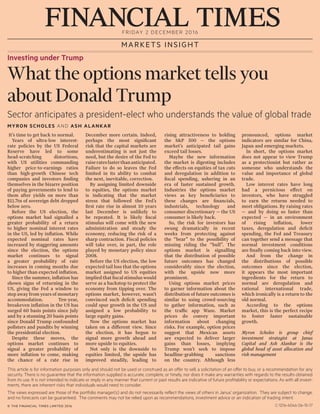Weitere ähnliche Inhalte
Ähnlich wie FT Article Reprint
Ähnlich wie FT Article Reprint (20)
FT Article Reprint
- 1. FRIDAY 2 DECEMBER 2016
MARKETS INSIGHT
Investing under Trump
What the options market tells you
about Donald Trump
Sector anticipates a president-elect who understands the value of global trade
MYRON SCHOLES AND ASH ALANKAR
© THE FINANCIAL TIMES LIMITED 2016
It’s time to get back to normal.
Years of ultra-low interest-
rate policies by the US Federal
Reserve have led to some
head-scratching distortions,
with US utilities commanding
higher price-to-earnings ratios
than high-growth Chinese tech
companies and investors finding
themselves in the bizarre position
of paying governments to lend to
them after yields on more than
$11.7tn of sovereign debt dropped
below zero.
Before the US election, the
options market had signalled a
greater probability of a return
to higher nominal interest rates
in the US, led by inflation. While
expected nominal rates have
increased by staggering amounts
since the election, the options
market continues to signal
a greater probability of rate
increases in coming months due
to higher than expected inflation.
Since the summer, inflation has
shown signs of returning in the
US, giving the Fed a window to
step away from years of monetary
accommodation. Ten-year,
breakeven inflation in the US has
surged 60 basis points since July
and by a stunning 20 basis points
since Donald Trump confounded
pollsters and pundits by winning
the presidential election.
Despite these moves, the
options market continues to
signal a greater probability of
more inflation to come, making
the chance of a rate rise in
December more certain. Indeed,
perhaps the most significant
risk that the capital markets are
underestimating is not just the
need, but the desire of the Fed to
raiseratesfasterthananticipated.
Failure to do so leaves the Fed
limited in its ability to combat
the next, inevitable, correction.
By assigning limited downside
to equities, the options market
is indicating that the market
stress that followed the Fed’s
first rate rise in almost 10 years
last December is unlikely to
be repeated. It is likely fiscal
stimulus will come with the new
administration and steady the
economy, reducing the risk of a
sharp contraction. Fiscal policies
will take over, in part, the role
played by monetary policy since
2008.
Before the US election, the low
expected tail loss that the options
market assigned to US equities
impliedthatfiscalstimuluswould
serve as a backstop to protect the
economy from tipping over. The
options market, however, wasn’t
convinced such deficit spending
could spur growth in the US and
assigned a low probability to
large equity gains.
Now the options market has
taken on a different view. Since
the election, it has begun to
signal more growth ahead and
more upside to equities.
Not only is the downside to
equities limited, the upside has
improved steadily, leading to
rising attractiveness to holding
the S&P 500 — the options
market’s anticipated tail gains
exceed tail losses.
Maybe the new information
the market is digesting includes
the effects on equities of tax cuts
and deregulation in addition to
fiscal spending, ushering in an
era of faster sustained growth.
Industries the options market
views as key beneficiaries to
these changes are financials,
industrials, technology and
consumer discretionary — the US
consumer is likely back.
So, the risk for investors has
swung dramatically in recent
weeks from protecting against
the “bear” to the possibility of
missing riding the “bull”. The
options market is signalling
that the distribution of possible
future outcomes has changed
considerably since the election,
with the upside now more
prominent.
Using options market prices
to garner information about the
distribution of future outcomes is
similar to using crowd-sourcing
to gather information, such as
the traffic app Waze. Market
prices do convey important
information about changing
risks. For example, option prices
suggest that Mexican assets
are expected to deliver larger
gains than losses, implying
Trump won’t seek to impose
headline-grabbing sanctions
on the country. Although less
pronounced, options market
indicators are similar for China,
Japan and emerging markets.
In short, the options market
does not appear to view Trump
as a protectionist but rather as
someone who understands the
value and importance of global
trade.
Low interest rates have long
had a pernicious effect on
investors, who have struggled
to earn the returns needed to
meet obligations. By raising rates
— and by doing so faster than
expected — in an environment
of rising inflation, lower
taxes, deregulation and deficit
spending, the Fed and Treasury
can together send a message that
normal investment conditions
are finally coming back into view.
And from the change in
the distributions of possible
outcomes since the election,
it appears the most important
ingredients for the return to
normal are deregulation and
rational international trade,
which ironically is a return to the
old normal.
According to the options
market, this is the perfect recipe
to foster faster sustainable
growth.
Myron Scholes is group chief
investment strategist at Janus
Capital and Ash Alankar is the
global head of asset allocation and
risk management
This article is for information purposes only and should not be used or construed as an offer to sell, a solicitation of an offer to buy, or a recommendation for any
security. There is no guarantee that the information supplied is accurate, complete, or timely, nor does it make any warranties with regards to the results obtained
from its use. It is not intended to indicate or imply in any manner that current or past results are indicative of future profitability or expectations. As with all invest-
ments, there are inherent risks that individuals would need to consider.
The views expressed are those of the portfolio manager(s) and do not necessarily reflect the views of others in Janus’ organization. They are subject to change,
and no forecasts can be guaranteed. The comments may not be relied upon as recommendations, investment advice or an indication of trading intent.
C-1216-6046 06-15-17
